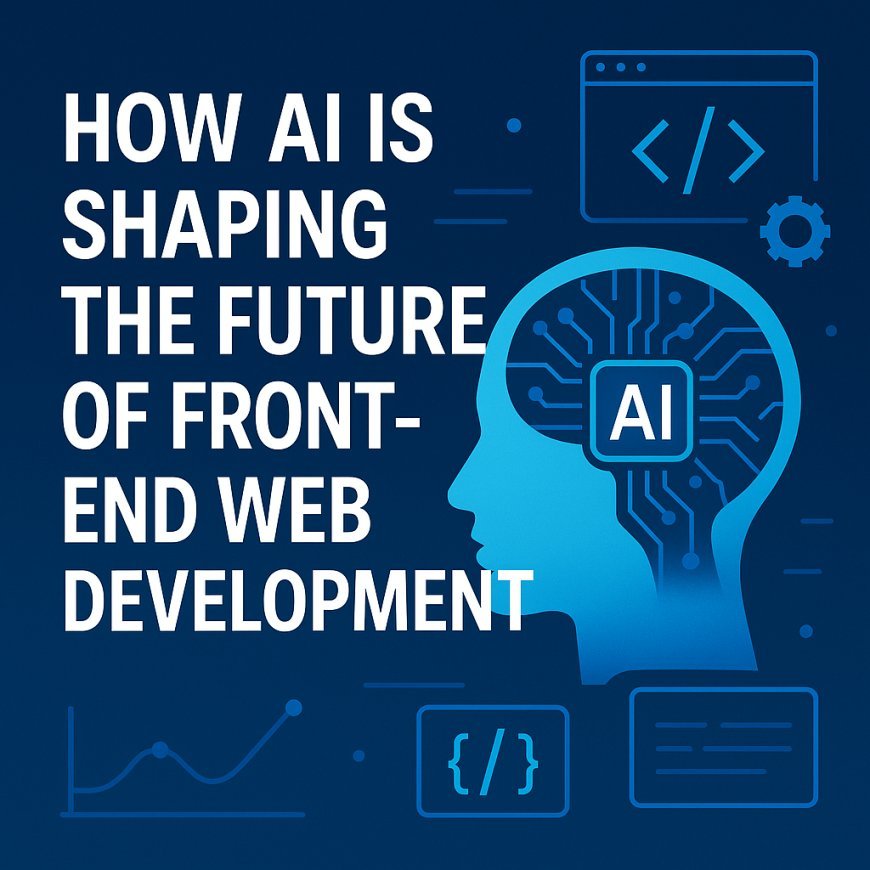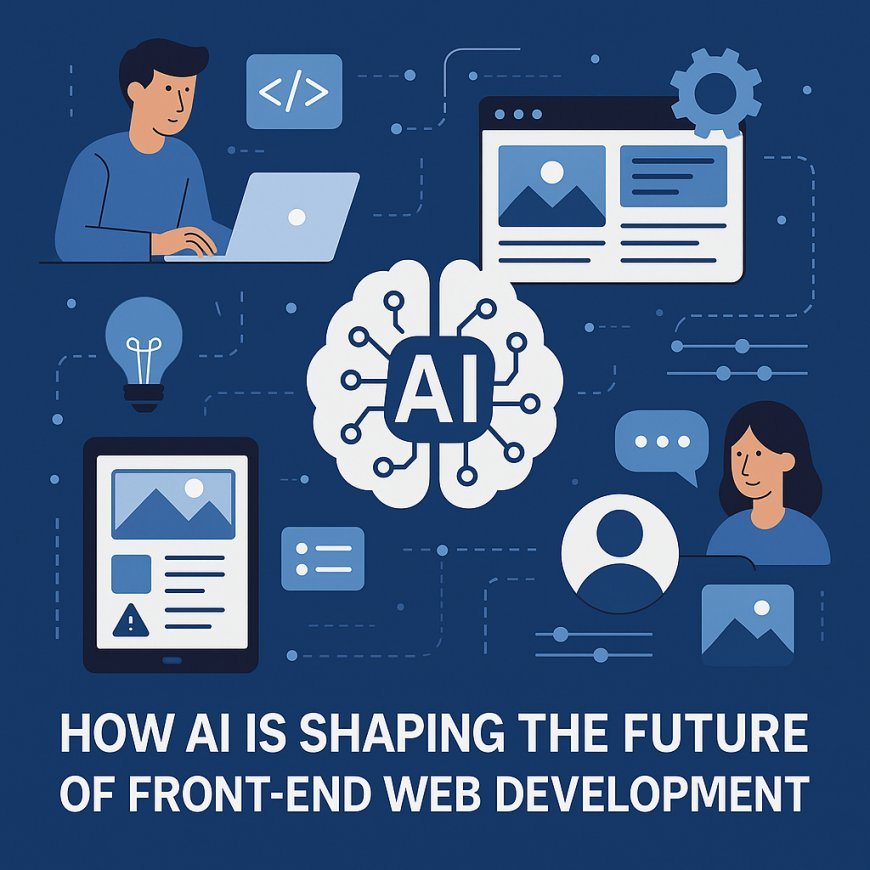How Is AI Shaping The Future Of Front-End Web Development?
The article explores the potential of AI in front-end web development, focusing on its automation and optimization of design systems.

The art of producing smooth, interactive user interfaces, which is front-end web development, has undergone relentless change in the last 10 years. However, accompanied by the emergence of artificial intelligence (AI), this industry is undergoing a change never seen before. AI is not a mere lingo anymore, but is becoming gradually an actual tool in the way the sites are designed, constructed, and optimized. The future of front-end development is changing because of AI, as it is a matter of course to organize and repackage age-old ways of doing things.
Automating Repetitive Work Overview
Automation of low-level coding tasks is another front-end impact of AI that is felt almost immediately. You can now speed up efforts such as writing boilerplate code, formatting CSS, or translating design documents into HTML with AI-enabled code helper programs like GitHub Copilot, Tabnine, and CodeWhisperer.
These AI coders will provide intelligent code suggestions, offer discovery opportunities, and will in some cases, compose multiple code blocks on the basis of a single text input. Consequently, a developer is able to work more on large problems, rather than devoting their time to syntax.
In addition, solutions such as Uizard and Anima are capable of turning design mockups into functioning code, bypassing the old handoff process between designers and developers. This considerably accelerates the process of prototyping and simplifies the work of teams.
User Personalization
Also, AI is opening the possibility of a real-time, targeted web experience. The static layouts in the past used to deliver the same content to the users. Machine learning algorithms can now identify specific user behaviour, including clicking, scrolling, and focusing on a page, to present an individualised user interface and even content.
As an example, a fashion online store can suggest a set of clothing, dependent on the past browsing activities, or a news site could place a higher priority on stories, based on past reading actions. All such dynamic changes are not only able to enhance the engagement but also are able to increase conversion rates.
Having AI on board, the front-end developers can create websites that would fluidly change to suit the specific user: provide personalized layouts, language options, accessibility features, etc., and in many cases, such a site would need no further coding after training the AI model.
Advancing Web Accessibility
One of the main questions during Front-End development is accessibility, and in this way, AI is progressing very well. The accessibility discrepancies that may include the absence of alt text, low color contrasts, or non-semantic HTMLs could be discovered and potentially remedied with the assistance of AI-based tools.
More than merely that of compliance, there are altogether fresh possibilities through which users utilize AI to access web content. The voice recognition systems and NLP (Natural Language Processing) enable users to operate interfaces without using their hands. Imaging recognition tools, such as Microsoft Seeing AI, assist visually impaired users in comprehending visual aspects present in a page via descriptive statements.
Such capabilities can now be integrated by a developer more freely and make the web more dynamic and friendly to everyone, including disabled individuals with physical and cognitive limitations.
Building Smarter Design Systems
Design systems allow consistency in a digital product. To solve this problem, AI is currently being incorporated into these systems to help in making design decisions and identifying discrepancies. The AI-enhanced design tools may determine the layouts, propose a superior choice of colors, and, in fact, predict the areas where the number of user interactions will decrease.
For example, the analysis of a heatmap can be AI-powered so that the most attended segments of a webpage can be determined. This data can be utilized by developers and designers to optimize the parts of UI along with enhancing general usability without having to conduct wide-scale A/B testing.
Combining AI and design systems allows front-end teams to go through the cycle of iteration and make more informed design decisions.
Creating Adaptive Interfaces
Future websites will not only be responsive but rather, adaptive. Artificial intelligence models allow tracking the way users engage with such elements as navigation menus, call-to-action buttons, or search bars. The interface may be modified to be smoother over time.
To give you an example, suppose that someone constantly goes to a particular part of a dashboard, the site may begin to bring that part to the forefront. Such kind of changes in real-time analytics and AI-based learning allow front-end developers to develop experiences that change according to the behavior of the user.
It is this flexibility that quits the static, rule-driven, user interface design for other dynamic interfaces that are alive and can learn and evolve.
Changing Developer Skill Sets
Since AI is increasingly integrated into front-end processes, developers should extend their scope. Although the classical instructions HTML, CSS, and JavaScript are unavoidable caveats, there is increasingly an imperative to master skills in other spheres, such as:
- Integrating machine learning APIs
- Working with AI-based design tools
- Applying ethical and privacy considerations
- Understanding natural language processing
- Analyzing behavioral data
In such a new world, albeit one where there is still coding to be done, the developer has become more of an orchestrator where mixes of tools, data, and AI capabilities are spun up to create dynamic, user-centric experiences.
Addressing Challenges and Ethics
On the one hand, the integration of AI is associated with numerous advantages, but it can also bring some new challenges. Job displacement is one of the major issues that exist, primarily among junior developers or designers. Nevertheless, instead of taking jobs away, AI might instead reconfigure, i.e., it will automate cliched work and drive a need to produce more up-leveled creative and analytical jobs.
The issues of ethics are primary as well. AI may contain stereotypes through trained AI systems fed on biased data. Taken to the extreme, there is the danger of personalization algorithms getting into the zone of obtrusive surveillance. Users' data application by developers should be carefully monitored as they need to be transparent and fair, and meet any regulations such as GDPR.
What Lies Ahead
In the future, front-end development will have more teamwork, data analysis, and AI support. Increased use of AI-aided design and code integration, more sophisticated ways of personalization routines, and voice or hand-based interaction are probably in our future.
Augmented reality (AR), virtual reality (VR), and other similar technologies will also start to shape the way in which front-end interfaces are produced, and AI will be central in adapting the content to immersion.
In short, the collaboration of the front-end development field and AI is only getting started. Individual developers who embrace them and their trends will not only safeguard their careers into the future but also be able to help influence the next age of the web.
Conclusion
Technology is changing the current state of front-end development, which is restrictive, reactive, into dynamic and smart. It is assisting developers to work more, make smarter designs, and create more inclusive, personalized digital experiences. The web of the future is not only responsive, it is also predictive, adaptive, and highly humanistic, owing to the sheer strength of AI.
What's Your Reaction?



